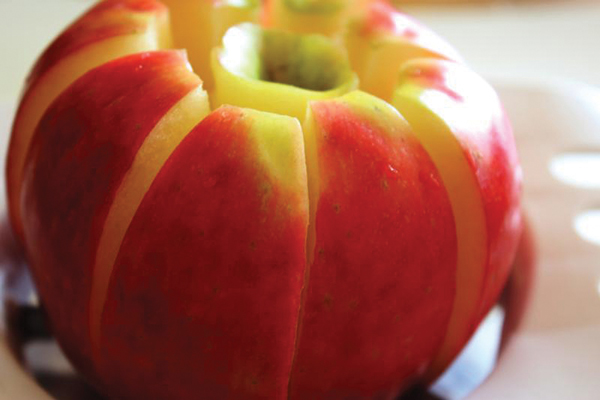News & Articles
Browse all content by date.

Apples have a kid problem. Considered one of the healthiest of fruits, they are cumbersome for children to eat. They are big and heavy. They scrape and bruise their little kid gums, and get their faces and hands all messy. Attempts to feed apples to kids results in major amounts of wasted apples.
Luckily, science has recently confirmed what parents-and anyone else who has prepared food for kids-have long known: kids are much more likely to eat apple slices than whole apples. According to a study by Cornell’s Food and Brand Lab, kids eat 60 percent more of the apples they are served if they are cut into pieces. That adds up to less waste, and presumably better health.
The other day, after reading about the study in the Washington Post, I noticed a half-eaten brown apple on the table. I cut off the brown parts, sliced the remaining apple into pieces, put them on a plate, and surreptitiously replaced them on the table. The roving school of piranhas otherwise known as my kids gobbled them up ruthlessly, and then asked: can we have more apple?
It goes to show how much we value convenience, a tendency behind the rise in processed foods. In recent years, processed foods have become shorthand for an unhealthy diet, and eliminating them from one’s diet has become a rule of thumb for eating better.
But the simple act of cutting an apple makes it technically a processed food, according to the USDA definition. In fact, by this definition most food that you could eat will be processed by the time it reaches your mouth. Nobody eats watermelon without cutting it either: Does that make watermelon a processed food?
Technically speaking, no. Unless the watermelon was dosed with a preservative and packaged, two hallmarks of processed foods. Both of these are arguably problematic: some preservatives, notably nitrites and sulfites, can be scary. And packaging inevitably ends up as pollution, or at best takes up space in landfills.
Despite our growing collective obsession with food labels, there is a reason why “processed food,” will never appear on a label. Labels go on packages, and any packaging to which such a label might be affixed is itself a proxy for any label.
Another concern with processed foods is the opportunities for quick and easy calories that processing presents. Try eating a bunch of wheat berries and see how far you get. But grind them into flour and bake it into bread, and those former grains of wheat will melt in your mouth. Less work processing fiber, or even chewing, means more calories extracted from food.
And then there are the artificial colors and preservatives, the stabilizers, emulsifiers, and other additives that fill the stereotypical processed meals, like what you might get at McDonald’s. Speaking of McDonald’s, unless we dine there we might not realize how many sliced apples they serve. According to the Post, for the last decade the company has actually been a pioneer in serving sliced apples to kids, as part of a healthy side option and more recently as a Happy Meal component. And the company currently uses about 10 percent of the nation’s apple harvest. Admittedly, the fact that McDonalds is serving sliced apples makes them seem more processed. And compared to whole apples, they are.
In addition to the packaging, steps must be taken to ensure that the slices won’t turn brown or rot. And while parents and others are well-aware that a squeeze of lemon will prevent browning, that doesn’t pass muster with USDA. This is why the agency’s Agricultural Marketing Service worked with private industry to develop a product line called NatureSeal, which includes “...patented, proprietary blends of vitamins and minerals which inhibit oxidation and maintain the natural flavor, texture and color of fresh-cut fruit and vegetables for up to 21 days.”
Meanwhile, the buzz over fresh cut apples couldn’t have come at a better time for Okanogan Specialty Fruits, which is about to bring its flagship product to market: a genetically modified apple that resists browning. The Arctic Apple, as it’s called, has had the gene for a certain enzyme switched off. This enzyme, polyphenol oxidase, causes browning. “By not having browning there is are a lot of good things happening,” explained Okanogan Specialty Fruits founder Neal Carter.That’s because en-route to creating melanin, which causes that off-putting brownish hue, polyphenol oxidase consumes polyphenols and vitamin c, aka the good stuff-”...what gives apples their flavor and aroma.” Arctic Apple has all the polyphenols and vitamin c, because it has lost its capability to digest itself.
Okanogen Specialty Fruits was recently purchased by Intrexon, which owns a majority stake in GM Salmon company AquAbounty. The Arctic Apple was approved for commercial sale in 2015, andthe crop currently on the trees will be for sale this fall. About 60,000 pounds of Granny Smith and Fuji apples will hit the market, all of which will be in the form of sliced apples.
The genetic modification, of course, involves a process all its own-a kind of processing that will probably end up being disclosed in a label. Whether the Arctic Apple or its NatureSeal’d sliced cousins are any better or worse for you than an apple you cut up at home is probably more in the realm of philosophy than health. But I can’t help but wonder if, like that watermelon, the best time to slice it open is right before you eat it. That seems to be the freshest option. The skin of an apple is a pretty good packaging, and cutting an apple doesn’t seem like much more work than opening a package (and then throwing it away, and taking out the trash, and paying for trash pickup, etc.) And if your kids are as crazy about knives as mine (emphasis on crazy), then helping them cut their own apples could be a teachable moment.
| Tweet |


